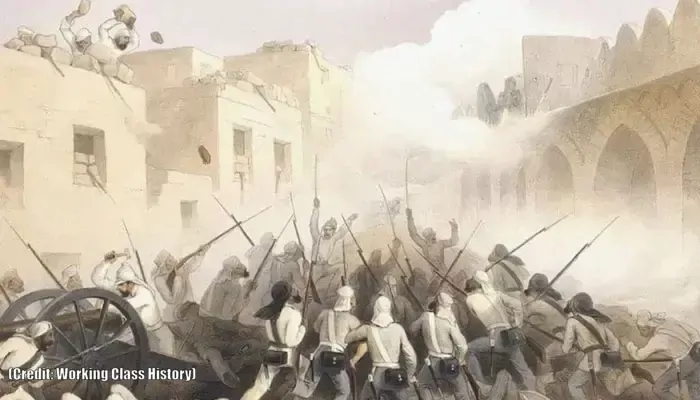
A landmark uprising that shook the British Empire, but does it truly deserve the “India's first freedom movement” tag?
Okay, first let’s get this straight that when we call the 1857 rebellion India’s first war of independence or freedom movement, it’s not because there were no uprisings before it. Earlier revolts did happen, no doubt, but they were mostly local, limited in scope, and often went unnoticed outside their regions. The 1857 uprising, on the other hand, spread like wildfire across north and central India, cutting across caste, class, and creed. Leaders like Mangal Pandey, Rani Lakshmibai, and Tantia Tope became symbols of resistance. It shook the foundations of British rule and lit a spark that future revolutionaries would carry forward. But that brings us to an important question: does sheer scale and impact make 1857 worthy of being called "India’s first war of independence"? See, history rarely offers us clear-cut answers, but it definitely gives us enough to dig deeper and ask the right questions. In this article, we’re not questioning 1857’s place in history, but simply trying to understand it more clearly, against the backdrop of India’s longer freedom struggle.
And here's to the 78th anniversary of India's Independence!
In 1857, the idea of a unified Indian nation simply didn’t exist. What existed instead was a fragmented subcontinent made up of princely states, old Mughal provinces, tribal territories, and British-administered regions. Historian Eric Stokes puts it clearly that "The rebellion was not a national war of independence, for the concept of an Indian nation was yet to be born." And also, people’s loyalties were tied more to their caste, region, religion, or ruler than to any pan-Indian identity.
When sepoys at Meerut revolted on May 10, 1857, their immediate concern wasn’t national freedom but the rumored use of cow and pig fat in rifle cartridges, which violated religious sentiments. As the rebellion spread, people took up arms for reasons unique to their local context. Rani Lakshmibai fought to protect her kingdom of Jhansi, not to liberate India. Nana Saheb sought to reclaim his Peshwa title and privileges. Bahadur Shah Zafar, the reluctant figurehead in Delhi, symbolized Mughal nostalgia more than national unity. So, in the absence of a shared national identity or goal, calling the 1857 uprising a war for Indian independence feels anachronistic. It was resistance, fierce and brave in parts, but not yet nationalist.

There was no single leader or unified command directing the rebellion. It was a patchwork of uprisings, each driven by different motivations. Mangal Pandey’s outburst in Barrackpore stemmed from religious fears; Rani Lakshmibai’s resistance was about succession rights; Nana Saheb was reacting to the loss of his pension. Peasants joined in some areas to oppose high taxes or corrupt local officials. As historian R.C. Majumdar notes, “The so-called First War of Independence was in reality neither the first, nor a war, nor for independence.” Bahadur Shah Zafar, declared Emperor of India by the rebels, had no real power or control. His sons and generals, like Bakht Khan, had some influence, but coordination across regions was severely lacking. Even the Azamgarh Proclamation, one of the rare political documents of the rebellion, while condemning British rule, fell short of articulating a vision for a unified nation.
While the rebellion swept through areas like Delhi, Kanpur, Lucknow, Jhansi, and Bihar, vast parts of India remained untouched. South India, including the Madras Presidency and princely states like Mysore and Hyderabad, remained quiet. The east beyond Barrackpore saw little activity. In Punjab, the British found allies among the Sikhs and Pathans, who feared a return of Mughal dominance.
Some princely rulers, on the other hand, stayed loyal to the British, valuing their own security over any broader political cause. Others, like the Nizam of Hyderabad or the Maharaja of Kashmir, calculated that rebellion wouldn’t serve their interests. This uneven participation underscores that the 1857 uprising, while widespread in places, wasn’t truly pan-Indian.
The motivations of many rebels were conservative as they aimed to restore old orders, not create new ones. Historian Michael Adas called it “the last effort of traditional India”, a fight to preserve, not to transform. The modern nationalist movement, driven by ideas of democracy, civil rights, and self-rule, would only gain shape decades later with reformers and freedom fighters like Dadabhai Naoroji, Bal Gangadhar Tilak, and eventually Gandhi and Nehru.
Well, none of this is to say the 1857 Rebellion wasn’t important. It was a dramatic rupture. It exposed the vulnerabilities of British rule, ended the East India Company’s control, and led to the formal takeover of India by the British Crown. It sowed the seeds of suspicion and fear that would haunt colonial administrators for years.
More importantly, it left behind a legacy of resistance. Its heroes became symbols for future freedom fighters. The uprising may not have been a national freedom movement in intent, but in hindsight, it became a reference point for one.
So, can we call the 1857 rebellion India’s First War of Independence? Perhaps not in the literal sense. But as a moment of defiance that sparked the long road to 1947, it surely deserves its place in the larger story of India’s freedom